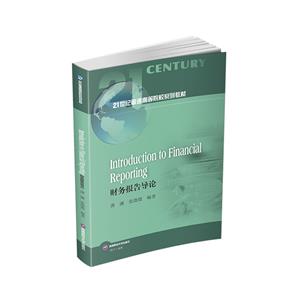Introduction to Finan Reporting(财务报告导论) 版权信息
- ISBN:9787550450356
- 条形码:9787550450356 ; 978-7-5504-5035-6
- 装帧:一般胶版纸
- 册数:暂无
- 重量:暂无
- 所属分类:>>
Introduction to Finan Reporting(财务报告导论) 本书特色
本教材遵循“十四五”规划期间教育部对高校本科教材建设的总体指导方针,坚持以习近平新时代中国特色社会主义思想为指导,落实《全国大中小学教材建设规划(2019-2022年)》和《普通高等学校教材管理办法》,力求满足普及化阶段高等教育人才培养的需要。本教材是以国际会计准则(IAS)为基础,由浅入深讲解编制个体经营者、股份公司财务报表的全英文教材。本教材英文专业术语准确规范,报告编制方法反映了国际会计准则的*新变化;建立了财务报告的基本体系,涵盖了财务会计的基础内容及报表编制的核心内容。本教材按照 50~70课内学时,课内、外学时比为1∶1设计教学与习题内容;在阐述会计理论与实务方法时,既注重会计理论的深度与广度,又强调会计实务的操作方法与应用。
Introduction to Finan Reporting(财务报告导论) 内容简介
本书是全英文教材。本书是针对会计和非会计专业学生学习财务报告的入门导论。本书以讲解个体经营者财务报告的编制为起点,在靠前财务报告概念框架指导下,通过对固定资产、无形资产、存货和股本等相关靠前财务报告准则的学习,逐步帮助学生掌握上市公司利润表、资产负债表、所有者权益变动表和现金流量表的编制技巧,并学会对财务报表的基本分析和解释。本书适合高校学生及对相关领域有兴趣学习的同学自学使用,有一定的普适性和出版价值。
Introduction to Finan Reporting(财务报告导论) 目录
目录Chapter 1 Statements of Profit or Loss: Sole Traders1.1 Introduction to the Statement of Profit or Loss1.2 Gross Profit and Net Profit1.3 Preparation of a Trading and Profit and Loss account1.4 Preparation of a Statement of Profit or LossExerciseChapter 2 Statement of Finan Position2.1 Contents of the Statement of Finan Position1. Assets2. Liabilities3. Capital2.2 Format of the Statement of Finan Position2.3 No Double Entry in Statements of Finan Position2.4 Drawing up a Statement of Finan PositionExerciseChapter 3 Statements of Profit or Loss and Statements of Finan Position: Further Considerations3.1 Returns Inwards and Return Outwards3.2 Carriage Inwards and Carriage Outwards3.3 The Second Year of a Business1. Adjustments Needed for Inventory2. Ledger Accounting for Inventory3. Other Expenses in the Trading AccountExerciseChapter 4 Inventory4.1 IAS 2 Inventories4.2 Cost of Goods Sold1. Recap2. Inventories Written off or Written down3. Inventory Destroyed or Stolen and Subject to an Insurance Claim4. Counting Inventory5. Accounting for Opening and Closing Inventories4.3 Measurement of Inventories1. Applying the Lower of Cost and NRV2. Determining the Cost of Inventory3. Different Valuations of Inventory4. Inventory Valuation and the Calculation of Profits4.4 Using Mark-up/Margin Percentages to Establish CostExerciseChapter 5 Irrecoverable Debts and Allowance for Receivables5.1 Irrecoverable Debts1. Introduction2. Writing off Irrecoverable Debts3. Irrecoverable Debts Written off and Subsequently Paid5.2 Allowance for Receivables1. Doubtful Debts2. Determining the Allowance for Receivables3. Allowance for Receivables: Ledger Accounting Entries4. Allowance for Receivables: Finan Statements5.3 Example: Irrecoverable Debts Written off and Allowance for Receivables CombinedExerciseChapter 6 Depreciation: Calculations and Double Entry6.1 What is Depreciation?1. Objective of Depreciation2. Definitions6.2 Causes of Depreciation1. Physical Depreciation2. Economic Factors3. Time4. Depletion6.3 Calculating Depreciation1. Methods of Depreciation2. Choice of Method3. Reviewing and Changing the Depreciation Method4. Reviewing and Changing Useful Life or Residual Value6.4 Accounting for DepreciationExerciseChapter 7 Accruals and Prepayments7.1 Introduction7.2 Accrued Expenses and Prepaid Expenses1. Accrued Expenses2. Prepaid Expenses3. Accruals and Prepayments in Finan Statements7.3 Accrual Principle and IncomeExerciseChapter 8 Provisions and Contingencies8.1 Provisions1.Definition2.Accounting for Provisions3.Measuring the Amount of Provisions8.2 Contingent Liabilities and Contingent Assets1.Contingent Liabilities2.Contingent Assets3.Decision Tree of IAS 378.3 Disclosure in Finan StatementsExerciseChapter 9 Tangible Non-current Assets9.1 Capital vs Revenue Expenditure1. The Distinction between Capital and Revenue Expenditure2. Capital Income and Revenue Income9.2 IAS 16 Property, Plant and Equipment1. Definition of Property, Plant and Equipment2. Measurement of Property, Plant and Equipment9.3 Revaluation of Non-current Assets1. Accounting Treatment for Revaluation Gain and Losses2. A Worked Example9.4 Non-current Assets Disposals1. The Principles behind Calculating the Profit or Loss on Disposal2. Accounting Treatment for Asset Disposals3. Accounting for Disposals of Non-Current Assets Given in Part Exchange9.5 Disclosure in Finan StatementsExerciseChapter 10 Intangible Non-current Assets10.1 Intangible Assets1. Intangible Assets Defined2. Accounting Treatment10.2 Research and Development1. Definition of Research and Development2. Recognition of Research and Development3. Accounting Treatment of Research and Development10.3 Disclosure in Finan StatementsExerciseChapter 11 Introduction to Company Accounting11.1 The Nature of a Limited Company1. Separate Legal Entity and Limited Liabilities2. The Classes of Limited Companies3. The Capital of Limited Liability Companies11.2 Equity: Share Capital1. Ordinary Shares and Preference Shares2. Accounting for Share Capital11.3 Equity: Retained Earnings and Other Reserves1. Retained Earnings2. Share Premium3. Other Reserves4. Dividends11.4 Bonus and Rights Issue1. Bonus Issue2. Rights Issue11.5 Ledger Accounts of a Limited Liability Company1. Taxation2. Loan Stock3. Finance CostsExerciseChapter 12 Preparation of Finan Statements for Companies12.1 IAS 1: Presentation of Finan Statements12.2 The Statement of Finan Position12.3 The Statement of Profit or Loss and Other Comprehensive Income1. Other Comprehensive Income and Basic Requirements2. Cost of Sales, Distribution Costs and Administrative Expenses3. Other Income12.4 The Statement of Changes in Equity12.5 Notes to the Finan Statements12.6 A Worked ExampleExerciseChapter 13 Statement of Cash Flows13.1 Introduction to the Statement of Cash Flows1. Purpose of the Statement of Cash Flows2. Cash versus Profit13.2 IAS 7 – Statement of Cash Flows1. Objective and Scope2. Definitions13.3 Presentation of the Statement of Cash Flows1. Cash Flows from Operating Activities2. Cash Flows from Investing Activities3. Cash Flows from Financing Activities4. Cash and Cash Equivalents13.4 An Example: Preparing a Statement of Cash FlowsExerciseChapter 14 An Introduction to Finan Analysis14.1 Basics of Finan Analysis1. Users of the Ratios2. Overview of Finan Statements14.2 Ratio Analysis1. Profitability Ratios2. Liquidity Ratios3. Gearing/Leverage Ratios4. Efficiency Ratios5. Investment Ratios14.3 Interpretating Finan Information1. A Worked Example2. Limitations of Ratio AnalysisExerciseAnswersChapter 1Chapter 2ChapterChapter 4Chapter 5Chapter 6Chapter 7Chapter 8Chapter 9Chapter 10Chapter 11Chapter 12Chapter 13Chapter 14
展开全部
Introduction to Finan Reporting(财务报告导论) 作者简介
薄澜,辽宁大学新华靠前商学院副教授、硕士生导师、英国德蒙福特大学访问学者。主讲课程:《初级财务会计》、《中级财务会计》与《会计实务》。张微微,辽宁大学新华靠前商学院讲师、硕士生导师。教学经验丰富,主讲课程:《初级财务会计》与《会计学基础》。





















